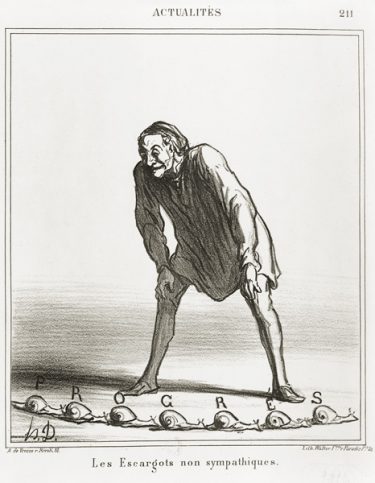This article originally appeared in The Skeptic, Volume 2, Issue 6, from 1988.
In 1850 a French inventor made a discovery he believed would revolutionise communications. With his insights the electric telegraph would become obsolete overnight. He predicted instantaneous communication around the globe — at the time an extraordinary idea, since wireless telegraphy would not be demonstrated by Marconi for another forty-five years. What made it all the more remarkable was that he had discovered the telepathic powers of the humble snail.
Jacques Toussaint Benoit was a character of his time. After a lifetime’s immersion in the occult, he was now on the verge of a breakthrough. Having observed the evolution of the new electric telegraph, he was aware there were problems. When in 1850 the first submarine cable was laid between England and France, the gutta-percha wire casings soon decomposed in the water, and contact with the brine rendered the wires useless. If electric telegraphy could not span the meagre English Channel, what hope was there for transatlantic communication?

What Benoit had in mind was a different force of nature, free from the trappings of gutta-percha and dry copper wires, a force that needed no conductor except the presence of living beings. He proposed to use animal magnetism. Benoit had recently discovered that two snails placed together, and subsequently separated, would remain forever united by a telepathic bond. When one was stimulated, an exchange of animal magnetism meant that the other, regardless of distance, also responded. Benoit had glimpsed the future of communication, and he was to be its pioneer.
Benoit was penniless, but he was charming. It was not long before he had persuaded Monsieur Triat, the manager of a Paris gymnasium, to be his angel. Benoit explained that he and his colleague, Monsieur Biat-Chrétien, then living in America, had hit upon a world-shaking idea. He assured Triat that he needed ‘only two or three bits of wood’ for the construction of his ‘snail-telegraph’, and that human communication would never be the same again.
At first, Triat believed absolutely in Benoit, providing him with lodgings and a steady allowance. Installed in his new Paris apartment Benoit set to work, but he soon became distracted, and people began to speculate that Triat’s money was funding more aspects of Benoit’s life than his snails.
When a year had passed, with Triat substantially out of pocket, and the snail-telegraph still unseen, Triat’s patience was gone. He demanded to see Benoit demonstrate the machine. Benoit stalled, but finally he agreed. With a grand title worthy of such a daring conception, the pasilalinic-sympathetic compass was unveiled.
It was a grand contraption indeed. At one end of Benoit’s apartment rested a huge wooden frame, a large horizontal disc suspended beneath. In the disc were twenty-four holes, each containing a zinc dish lined with a cloth soaked in copper sulphate solution. The cloth was fixed by a copper blade, and in the dish, secured by glue, sat a living snail. Against each dish was written a letter of the alphabet. To transmit the letter, the operator would touch the snail in the dish, causing a sympathetic reaction in the corresponding snail in the other half of the apparatus — a device of identical construction at the other end of the room.
Lack of space had forced Benoit to construct both stations of the telegraph in the same room, but as he readily explained — this was immaterial. Distance has no meaning for the telepathic snail — was not Benoit himself in daily ‘snail-telegraphic’ communication with his American collaborator? Full of confidence, Benoit invited Triat and Monsieur Allix, a journalist from La Presse, to a demonstration of the machine.
On the morning of 2 October 1851, the demonstration began, but at once Triat and Allix objected to the location of the instruments. Could they not at least be separated with a curtain? Alas, replied Benoit, that would not be technically possible.
Nevertheless, Triat took his place at the controls of one of the stations, and began to prod the snails to spell out his message. Benoit was supposed to remain at his receiving station on the other side of the room, but found it essential to cross between the machines on one pretext or another.
Triat was now certain of what he had begun to suspect in the recent months. Benoit was a rogue, and he had been hoaxed, a witness to nothing better than farce. Allix, on the other hand, was completely convinced. On 27 October a glowing article appeared in La Presse: “…snails which have once been put in contact, are always in sympathetic communication. When separated, there disengages itself from them a species of fluid of which the earth is the conductor, which develops and unrolls, so to speak, like the almost invisible thread of the spider, [but] the thread of the escargotic fluid is invisible as completely and the pulsation along it as rapid as the electric fluid.”
Now skeptical, Triat demanded another test, this time with strict controls. Benoit agreed, and a date was set. But when the day came, Benoit had vanished.
In the following months Monsieur Benoit was seen wandering the Paris streets, destitute and deranged. He died two years later, and with him disappeared forever the dream of the snail-telegraph.



